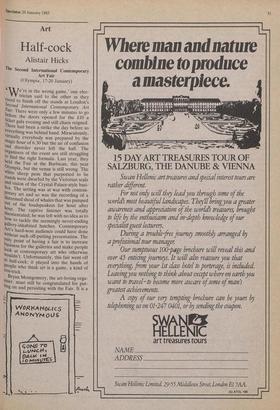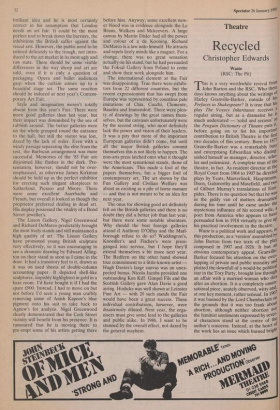Art
Half-cock
Alistair Hicks
The Second International Contemporary Art Fair (Olympia, 17-20 January)
Ve're in the wrong game,' one elec- trician said to the other as they raced to finish off the stands at London's Second International Contemporary Art Fair. There were only a few minutes to go before the doors opened for the £10 a ticket gala evening and still chaos reigned. There had been a strike the day before so everything was behind hand. Miraculously, virtually everybody was prepared by the magic hour of 6.30 but the air of confusion and disorder never left the hall. The organisers of the event are still struggling to find the right formula. Last year, they held the Fair at the Barbican, this year Olympia, but the venue is still wrong. The White sheep pens that purported to be stands were dwarfed by the Victorian scale and vision of the Crystal-Palace-style basi- lica. The setting was at war with contem- porary art and so was the recording of a distressed shoal of whales that was pumped out of the loudspeakers for hour after hour. The captive listener was totally disorientated; he was left with no idea as to how to tackle the seemingly never-ending gallery-inhabited hutches. Contemporary Art's hard-won audience could have done without such off-putting presentation. The Only point of having a fair is to increase business for the galleries and make people look at contemporary art who otherwise Wouldn't. Unfortunately, this fair went off at half-cock; it played into the hands of People who think art is a game, a kind of eon-trick.
Bryan Montgomery, the art-loving orga- niser, must still be congratulated for put- ting on and persisting with the Fair. It is a brilliant idea and he is most certainly correct in his assumption that London needs an art fair. It could be the most perfect tool to break down the barriers, the inhibitions the British suffer against the visual arts. However, the public need to be enticed delicately to the trough, not intro- duced to the art market in its most ugly and raw state. There should be some visible differences in the way sheep and art are sold, even if it is only a question of packaging. Opera and ballet audiences gasp when the curtain comes up to a beautiful stage set. The same reaction should be induced at next year's Contem- porary Art Fair.
Style and imagination weren't totally absent from this year's Fair. There were more good galleries than last year, but their impact was diminished by the sea of rubbish around. The better galleries were on the whole grouped round the entrance to the hall, but still the visitor was lost, dazed by the lack of order. Even with a windy passage separating the elite from the rest, the Barbican arrangement was more successful. Memories of the '85 Fair are disjointed like flashes in the dark. Pre- sentation, however, should not be over- emphasised, as otherwise James Kirkman should be held up as the perfect exhibitor for erecting such elegant altarpieces to Sutherland, Picasso and Moore. There were some excellent Auerbachs and Freuds, but overall it looked as though the proprietor preferred dealing in dead art. His display possessed the vitality of a Bond Street jeweller's.
The Lisson Gallery, Nigel Greenwood and Richard DeMarco predictably brought the most lively stands and still maintained a high quality of art. The Lisson Gallery have promoted young British sculpture very effectively, so it was encouraging to see a dramatic drawing by Edward Alling- ton on their stand as soon as I came in the door. It had a transitory feel to it, drawn as it was on used sheets of double-column accounting paper. It depicted shell-like sculptures, impishly highlighted in gold in a bare room. I'd have bought it if I had the spare £900. Instead, I had to move on but not before I'd seen a young man craftily removing some of Anish Kapoor's blue pigment onto his suit to take back to Agnew's for analysis. Nigel Greenwood clearly demonstrated that the Cork Street vicinity will benefit from his presence. It is rumoured that he is moving there to pre-empt some of his artists getting there before him. Anyway, some excellent new- er blood was in evidence alongside the Le Bruns, Walkers and Mckeevers. A large canvas by Martin Disler had all the power and colour of a de Kooning. Richard DeMarco is a law unto himself. He attracts and repels lively minds like a magnet. For a change, there was no great sensation actually on his stand, but he had persuaded the Foksal Gallery from Poland to come and show their work alongside him.
The international element at the Fair was disappointing. True there were exhibi- tors from 22 different countries, but the recent expressionism that has swept from Europe was represented by countless pale imitations of Chia, Cucchi, Clemente, Baselitz and Immendorf. There were plen- ty of drawings by the great names them- selves, but the canvases unfortunately were by the second string, who most definitely lack the power and vision of their leaders. It was a pity that more of the important European galleries didn't come, but until all the major British galleries commit themselves this is not likely to happen. The non-arts press latched onto what it thought were the most sensational stands, those of the Americans. This made a fool of the papers themselves, but a bigger fool of contemporary art. The art shown by the Fun Gallery and Civilian Welfare was about as exciting as a pile of horse manure — and that is not meant to be an idea for next year.
The onus for showing good art definitely fell on the British galleries and there is no doubt they did a better job than last year, but there were some notable absentees. Why should the best foreign galleries attend if Anthony D'Offay and the Marl- borough refuse to do so? Waddington's, Knoedler's and Fischer's were press- ganged into service, but I hope they'll extend themselves a bit more next year. The Redfern on the other hand showed true commitment to a little-known artist Hugh Davies's large canvas was an unex- pected bonus. Nicola Jacobs provided one outstanding Ken Kiff. Gimpel Fils and the Scottish Gallery gave Alan Davie a good airing. Hodicke was well shown at Leinster Fine Art — with 20 such stands the Fair would have been a great success. These individual contributions, however, were disastrously diluted. Next year, the orga- nisers must give some lead to the-galleries and public alike. In 1986, I want to be stunned by the overall effect, not dazed by the general mayhem.











































 Previous page
Previous page